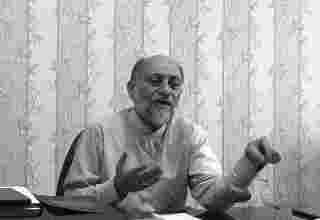
Baha’is in Jordan
By: Mohammad Gogani
Abstract
Jordan is a country in South-West Asia that was established under the guardianship of England after the end of the First World War and the collapse of the Ottoman Empire In 1948. It became a kingdom with the changes made in its borders and limited to Israel from the west. The population of Jordan is more than 11.1 million, and Islam is the official religion and the basis of the Jordanian constitution. More than 97.2% of people are Muslims. The number of Baha’is in Jordan in the mid-1970s, according to the annual official statistics of the National Baha’i Assembly to the Baha’i administrative organization, was around 130, which, considering the small population growth rate in Jordan does not seem to be the number of registered Baha’is at present of 200 people. The government has prohibited Muslims from converting to other religions and also proselytizing Muslims to another religion.
The government does not recognize Druze and Baha’i Faiths. The government does not allow Baha’is to establish and register schools or places of worship. The National Baha’i Assembly of Jordan was established in the mid-1970s, so it is one of the latest assemblies. Most of the Baha’is of Jordan live in the village of Adasiyeh. The basic core of Baha’is in Jordan is formed by Baha’i farmers from the villages of Maryam Abad and Mahdi Abad in Yazd, whom Abdu’l-Bahá called them to Haifa to farm for him in the lands of Adasia in that region, according to the traditional method of Iran’s lords and serfs.
The Baha’i Organization of Jordan has been run by a predominantly Iranian family for many years. The printing of Baha’i books is also not legally and officially allowed. Baha’is do not have official and open preaching in Jordan, but their preaching sessions for children, teenagers, and young Muslims are done secretly.
Key words: Baha’is in Jordan, prohibition of Baha’i propaganda, Baha’i population
*********************************************************************
Book introduction
Faith in Iran
Looking at the faith of Bab from the perspective of reforming the Shia religion
By: Mirza Yahya Dolatabadi
Corrector:
Seyyed Moqdad Nabavi Razavi
By: Seyyed Mohammad Hadi Sajjadi
Abstract
The book “Faith in Iran” written by Mirza Yahya Daulatabadi is one of the elders and strugglers of Babi Faith who, despite being assigned the position of successor of Mirza Yahya Sobh Ezal and the position of Martyr of Bayan , but due to the common secret life of Babi, there are suspicions about being a Muslim or becoming a Muslim according to some historical writings at the end of his life.
Seyyed Meqdad Nabavi Razavi aims to reveal the nature of Babi’s beliefs, contrary to the Shi’ite and Islamic beliefs of Mirza Yahya, with a historical and argumentative research in the first step, based on letters and documents, and after that, examines the issues has discussed in this book and its purpose, contrary to the historical appearance, in describing the development of Islam in Iran and dealing with the 12th century Shari’ah during the Great Absence of the 12th. Imam. Mirza Yahya tries to provide a suitable platform for including the claims of Seyyed Ali Muhammad Bab through the Shiite beliefs reforms., That is why the explanation of the book’s title, “Looking at Babi’s religion through the lens of Shi’ism reform” has been added.
Keywords:
Mirza Yahya Daulatabadi, religion in Iran, idea of religious reform in Iran, Mahdism, Allameh Majlisi
***************************************************************************************
A new edition of the book “Faith in Iran”.
(Written by Mirza Yahya Dolatabadi)
By:Seyyed Moqdad Nabavi Razavi
Abstract
Mirza Yahya Daulatabadi – who is one of the most important influencers of the Qajar era – as the successor of Mirza Yahya Sobh Azal (the successor of the Bab) had such a hidden existence and concealment of his beliefs that many historians consider him a Muslim or a converted Babi.
Apart from the narratives that show his Babi secret belief, the book Faith in Iran – which was written in the last years of his life – shows the eternal nature of his secret belief.
This article introduces a newly discovered version of this book written by his successor, Mohammad Sadegh Ebrahimi, and provides historical and reliable points. This version has some advantages compared to the printed version of the Book of Faiths in Iran, which was printed by the author.
Keywords:
Mirza Yahya Dolatabadi, book “Faith in Iran”, Mohammad Sadeq Ebrahimi, Mirza Mohammad Khan Qazvini.
Oooooooooooooooooooooooooooooooooooooooooooooooooooooooooooooooo
Acre Baha’i community
Eric Cohen
Translated to Persian by Hamid Farnaq
Abstract:
After the death of Baha’u’llah, the founder of Baha’i, his son Abbas Effendi became the leader according to his father’s will. According to the will, his half-brother Muhammad Ali was supposed to succeed him. However, the Baha’is split due to enmity between the two brothers. One group turned to the West and gradually separated itself completely from Islam; while the traditional group was trying to maintain its separation within the boundaries of basic Baha’i teachings and beliefs. In this article, we specifically focus on the more traditional faction, based in Acre, which today represents a kind of religious trend. Many members of the Baha’i family, and many of his closest associates, supported Muhammad Ali.
Abdu’l-Bahá apparently had the support of minor Baha’is in Acre and the majority of Baha’is outside Acre, but within a short time he succeeded in becoming the leader of the mainstream Baha’i movement. Abdu’l-Bahá, the leader of the Baha’is, was clearly in close contact with the British during the last years of Turkish rule in Palestine.
The of table the contents:
Introduction
۱- Appointment of Subh-i-Azal and fraternal hostility
۲- The Struggle and Separation of the Baha’ Sons :Historical Background
۳- The Social Structure of the Baha’i Community of Acre
۴- The Relationship of the Baha’is of Acre to the Haifa Center, the State of Israel and Islam
۵- Discussion
Key words: Sociology of the Baha’i Sect, Sobhe Azal, Bahaullah’s children quarrel with each other, violators in the Holy Land, ex-communication, the delegation of the Amrallah,
Baha’i from the point of view of Baha’i intellectuals and critics
Abdul Hossein Ayati
By: Narges Haji Ghorbani
Abstract:
The late Abdul Hossein Ayati, known as Avarah, is a Baha’i writer, researcher and critic who, after 18 years of being an active member of the Baha’i organization, was rejected by Shoghi because of his critical positions and protesting views towards Baha’ism and its leaders, especially Shoghi Effendi. Despite his services to the Baha’i community, he was harassed. Although Abdu’l-Bahá and Shoghi Effendi, the Baha’i leaders had issued numerous tablets describing Ayati and introduced him as a servant and activist, but after hearing his criticisms and points of view, they preferred not to have seen his records and issued confirmations about him, Ayati who was a Baha’i historian himself, announced with careful study of Babi and Baha’i history that the Baha’i leaders are continuously cleaning up the Baha’i texts and changing and distorting them.
Ayati does not consider Baha’i as a divine religion and believes that Baha’i is a dangerous sect and movement that not only has nothing new to say, but its teachings are also a false adaptation of Islam and other religions.
Ayati did not consider Baha’u’llah, Abdu’l-Baha and Shoghi Effendi to be infallible and considers the leaders of this sect to be political and dependent people who seek financial benefits and rule the world.
Key word:
Baha’ism, distortion of history, rejection, Abdul Hossein Ayati, Kashf ul-Hial, al-Kawaqib al-dorriah
***********************************************************************
Final days (Apocalypse)
A discussion about the apocalypse with a view of the Babis and Baha’is
By: Abdul Hossein Fakhari
Abstract:
In this article, the concept of the end of time ( Apocalypse) has been discussed and it has been shown that we are now in the era of the end of time, i.e. the era of prophethood of the prophet of the end of time, Hazrat Muhammad bin Abdullah (pbuh), which will begin with his mission and continue until the resurrection. In the continuation of the discussion of the end of time (Apocalypse) between different religions, they also believe that the promised savior will appear and justice will replace oppression in the world. According to the received news, the harsh conditions of the end of time will cause many losses for people, so that many people will lose their faith and leave the religion.
In the end of time, sectarians have been and are active in order to create a gap and division between the believers, and false claimants have appeared in the form of religion and by seducing groups of the society. They have created divisions or multiple factions, and while misleading people, they have prepared the political goals of the enemies of religion. Among these sects in our time, Wahhabism and Baha’ism are the two causes of division and deviation, both of which have colonial roots and have caused heavy losses to Islam and Muslims. However, in this difficult time of the apocalypse in which we are living, we are obliged to be steadfast in religion and steadfast in faith.
Keywords: end of time, savior, promised religions, Babiat, Baha’i













